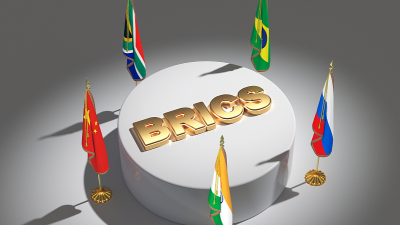Russia Announced Preparations for the Creation of International Reserve Currency under BRICS Auspices (Brazil, Russia, India, China, South Africa)
A counter BRICS system is on the cusp of becoming a reality.

All Global Research articles can be read in 51 languages by activating the “Translate Website” drop down menu on the top banner of our home page (Desktop version).
To receive Global Research’s Daily Newsletter (selected articles), click here.
Visit and follow us on Instagram, Twitter and Facebook. Feel free to repost and share widely Global Research articles.
***
Russian President Vladimir Putin announced on June 22 that BRICS (Brazil, Russia, India, China, South Africa) is preparing to create an international reserve currency. Following the launch of Russia’s military operation in Ukraine, Western countries swiftly sanctioned about half of Russian FX reserves. BRICS countries, but especially China, took notice of the speed and stealth at which sanctions were imposed, thus projecting the necessity of a BRICS reserve currency.
“The Russian Financial Messaging System is open for connection with the banks of the BRICS countries. The Russian MIR payment system is expanding its presence. We are exploring the possibility of creating an international reserve currency based on the basket of BRICS currencies,” the Russian president said in a video message to BRICS forum participants.
“Businessmen of our countries are forced to develop their business under difficult conditions where Western partners neglect the basic principles of market economy, free trade, as well as the inviolability of private property,” Putin added.
Effectively, the barrage of Western sanctions has forced Russia to seek new markets and strengthen ties with other countries to economically survive. In this way though, it has also forced a rapid reshaping of the global economic system as the US dollar no longer reigns full supremacy and huge markets continue to emerge in Asia and Africa.
Moscow is actively redirecting the export of its hydrocarbon products from European countries to Asia, but especially China and India. According to China’s Central Customs Administration, Russian-Chinese commodity exchanges increased by nearly a third in the first five months of 2022, reaching a sum of about $66 billion. The sharp growth in commodity trading has been linked by experts to an increase in energy prices, which account for about 70% of Russia’s exports to China.
Such a strategy will allow Russia to minimise losses caused by Western sanctions this year. Experts also believe Russia can increase purchases of a range of components, spare parts and other products from Beijing, circumventing US and EU restrictions.
From January to May this year, commodity trading between Russia and China increased by 28.9% compared to the corresponding period last year, reaching $65.81 billion. During that period, Chinese exports to Russia rose 7.2% to reach $24.56 billion, while Moscow increased exports of its products to Beijing by 45.5% to $41.25 billion.
Although the EU and the US have decided to stop Russian oil imports, China shows great interest in buying energy from Moscow. This is an especially important market as demand for fuel in China in the post-COVID-19 period continues to grow.
China and India are crucial for Russia to minimise as much as possible the losses caused by sanctions, primarily because of the oil embargo. In addition to energy, Moscow is actively delivering metals, wood, fertilizers, chemicals, food products and diamonds to China.
Due to the imposition of sanctions and the departure of many Western companies from the Russian market, a fairly large volume of parallel imports of European and US products from China and India are also expected. As explained by Moscow, under the conditions of external restrictions, such a measure will help secure the domestic market with the requested products and stabilise their prices.
It should be noted that in 2021, the volume of inter-trade between Moscow and Beijing increased by 36% to a record $147.1 billion. At the same time, experts are confident a new record could be set in 2022. It is predicted that Russian-Chinese commodity exchanges could reach $185 billion.
According to OPEC forecasts, by 2030 a quarter of the world’s oil demand will be made up by only China and India. Given this and the growth of parallel imports to Russia, it is not ruled out that the two countries’ commodity exchanges will reach $200 billion by the end of 2022.
Within the context of Western sanctions and increased trade between BRICS, a BRICS reserve currency is all the more imperative. Sergey Storchak, chief banker of Russian bank VEB.RF, said on June 20: “If the voices of emerging markets are not being heard in the coming years, we need to think very seriously about setting up a parallel regional system, or maybe a global system.”
Although there has been ongoing discussions within BRICS for years to accelerate payments in national currencies, it appears that Putin’s announcement, and the way a deDollarization has been forced upon Russia, a counter BRICS system is on the cusp of becoming a reality. As Moscow’s trade with India and China accelerates, these mega countries and economies cannot risk being locked out of a Western-dominated global system, and thus an establishment of a BRICS alternative serves their interests best.

